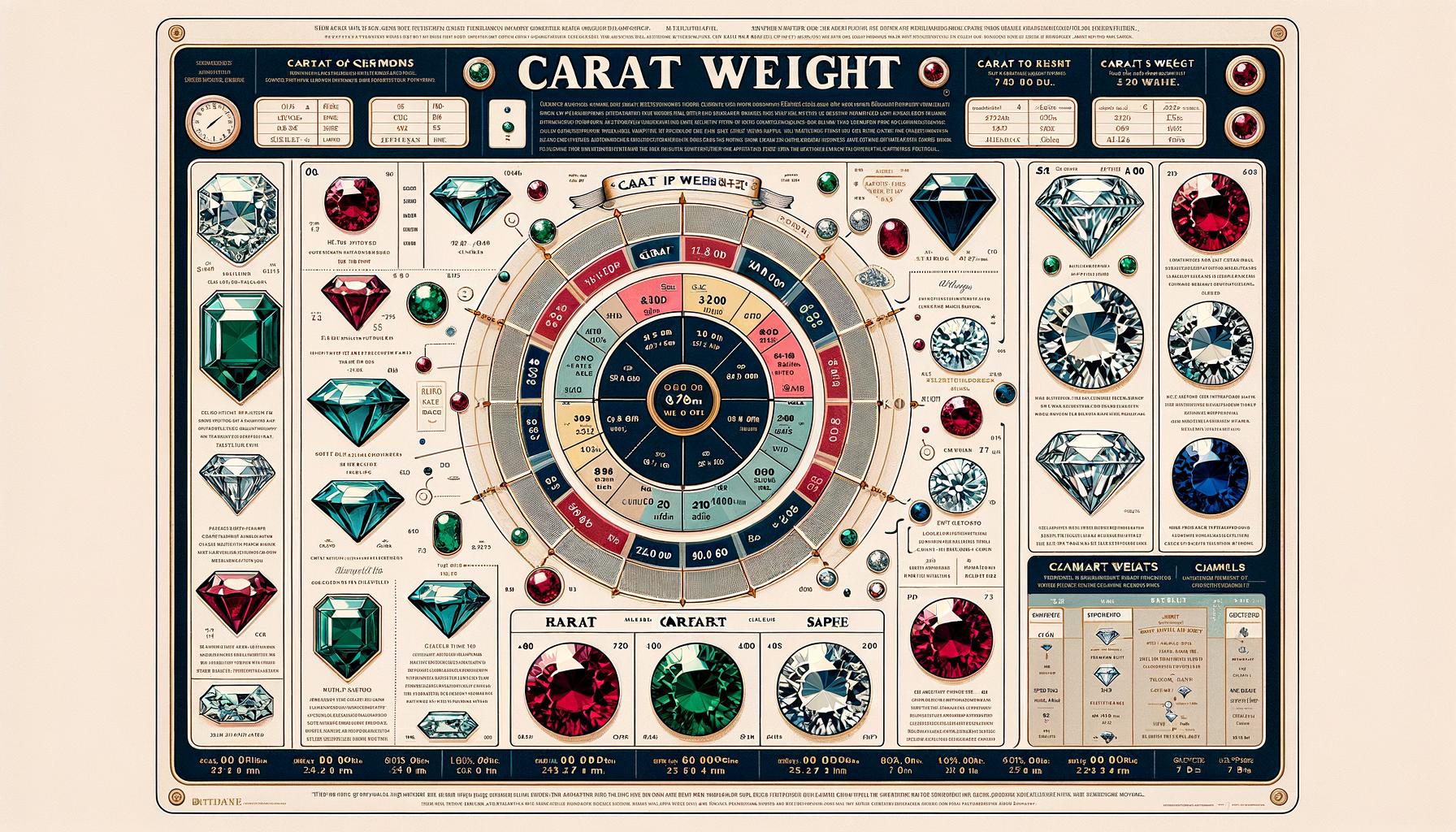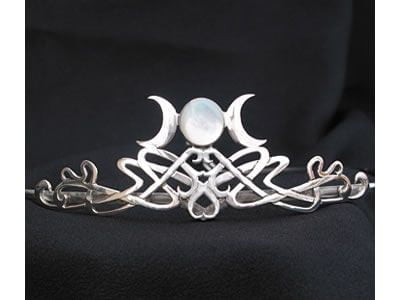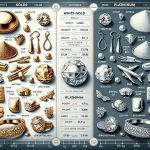Understanding carat weight in gemstones and diamonds is a fundamental aspect of the jewelry-buying experience. At its core, carat weight determines not only the size but also significantly influences the value of these precious stones. This key measurement has roots that stretch back centuries, adding layers of tradition and scientific precision to modern gemology. Delving into the origins and critical importance of carat weight offers valuable insight for anyone looking to make an educated purchase.
The term “carat” finds its historical origins in the ancient practice of weighing gemstones against the seeds of the carob tree, which were consistently uniform in weight. This rudimentary method evolved over time, leading to today’s highly meticulous digital scales used by gemologists. Understanding this transformation from primitive weighing techniques to state-of-the-art precision tools underscores why carat weight remains such a crucial determinant in the jewelry industry.
In practical terms, carat weight serves as one of the bedrock valuation principles when appraising gemstones and diamonds. Whether you’re buying a single diamond engagement ring or a collection of colored gemstones, knowing how carat weight affects both beauty and cost is indispensable. Becoming well-versed in this topic can enhance your ability to make informed decisions and invest wisely in pieces that will be cherished for years to come.
The Difference Between Carat and Karat
People often confuse “carat” and “karat,” but they refer to completely different measurements in the jewelry world. “Carat” (ct) is a unit of weight used for gemstones and diamonds, while “karat” (kt) denotes the purity of gold. Understanding carat weight in gemstones and diamonds is crucial for evaluating their value, whereas karat is essential when considering the quality and purity of gold jewelry.
Common misconceptions arise because the terms sound similar, yet they measure entirely different attributes. For instance, while a one-carat diamond weighs 200 milligrams, a one-karat gold piece indicates that it consists of 1/24 part pure gold. The term “karat” comes from the Medieval Latin word “caratus,” which was used to describe gold purity. On the other hand, “carat” has origins tied to the carob seeds historically used as counterweights.
To clear up these common misconceptions:
- Carat weight is used exclusively for measuring precious stones like gemstones and diamonds.
- Karat purity refers strictly to gold composition.
By understanding these distinctions, consumers can make better-informed decisions whether they’re buying an engagement ring or investing in fine jewelry. Always ask your jeweler whether they’re referring to carats or karats to ensure you’re getting exactly what you’re paying for.
How Carat Weight Is Measured
When it comes to understanding carat weight in gemstones and diamonds, precision is key. Jewelers use highly accurate tools to ensure that each stone is measured with utmost accuracy. The most common tool used today is an electronic digital scale specifically calibrated for gemstones and diamonds. These scales are capable of measuring weight down to the hundredth or even thousandth of a carat, allowing for precise and reliable measurements.
The process of weighing a gemstone or diamond begins with calibrating the scale to ensure it reads correctly. The gemstone is then placed on the scale carefully; even a small particle of dust can affect the reading due to the high level of sensitivity required. Typically, professional jewelers will perform multiple measurements to account for any potential discrepancies and ensure consistency in their results.
Several factors can affect how carat weight is measured beyond just the tools used:
- Temperature: Gemstones can expand or contract slightly with temperature changes, affecting their weight marginally.
- Atmospheric pressure: Variations in air pressure can also impact measurements, though this effect is often negligible.
- Cleanliness: Residual substances on the stone’s surface can add imperceptible amounts of weight, altering the measurement subtly.
In addition, environmental conditions need to be controlled during weighing as these minute differences might sway the final assessment. With these careful measures in place, professional gemologists can accurately determine carat weight, thereby helping consumers make informed decisions based on precise data rather than estimates or assumptions that could lead to undervaluation or overvaluation.
The Impact of Carat Weight on Value
The carat weight of a gemstone significantly influences its price, making it one of the foremost considerations for consumers and jewelers alike. Generally, as the carat weight increases, so does the price per carat.
This is because larger gemstones and diamonds are rarer, and hence command a premium. For instance, while a 1-carat diamond may have a certain price point, two 0.5-carat diamonds combined will not cost the same as the single 1-carat diamond due to this rarity factor.
To delve deeper into understanding how carat weight affects value, it’s crucial to comprehend the concept of “price per carat.” As gemstones increase in size, they do not just proportionally multiply in price. Instead, their value often spikes exponentially past certain benchmarks (like 0.5-carat, 1-carat, etc). For example:
- A 0.9-carat diamond might cost $4,000 per carat.
- A similar quality diamond that hits the 1-carat mark could cost $6,000 per carat.
Thus, understanding these incremental jumps can aid buyers in making more informed decisions regarding their purchases.
Another interesting aspect is comparing the value of multiple smaller stones versus a single larger stone with equivalent total carat weight. While four diamonds totaling 1 carat (each at 0.25 carats) may cumulatively have less value than a single brilliant-cut diamond weighing precisely 1 carat by itself. This disparity arises due to cutting complexities and market demands for larger individual stones.
This comparison becomes crucial when considering jewelry settings that might involve several smaller stones or opting for one centerpiece gem-impacting both aesthetic appeal and investment potential. Therefore, comprehending these nuances aids significantly in understanding carat weight in gemstones and diamonds and assists buyers in navigating their options wisely to maximize both beauty and value within their budgets.
Carat Weight vs Gemstone Dimensions
While carat weight is a crucial metric in determining the value of gemstones and diamonds, it is essential to understand that it does not always directly correlate with the physical size or dimensions of the stone. Many consumers are surprised to learn that two gemstones of identical carat weight can look quite different in size.
This discrepancy arises from variations in proportions, shapes, and cuts of the stones. For instance, a well-cut round diamond and a shallower cut oval diamond of the same carat weight will have differing surface areas, making one appear larger than the other.
An essential factor that plays into these variances is the density of different gemstones. Density refers to how much mass a stone has per unit volume. For example, sapphires and diamonds might be compared at similar carat weights, but sapphires have higher density.
This means a 1-carat sapphire will appear smaller than a 1-carat diamond because it’s more tightly packed within its structure. Understanding carat weight in gemstones and diamonds goes beyond simple measurements; it requires an appreciation for how these physical properties interact to affect perceived size.
The cutting style also significantly influences how sizable a gemstone appears relative to its carat weight. Stones cut deeply may hide some of their mass below the setting’s visible surface, whereas those with shallow cuts can maximize their spread at the expense of depth.
This knowledge becomes particularly useful when purchasing jewelry intended to make an impression while staying within budget constraints. By selecting cuts that enhance visual impact without requiring significantly higher carat weights, buyers can achieve desirable aesthetics without necessarily escalating costs.
| Factor | Effect on Size Perception |
|---|---|
| Density | Higher density stones appear smaller at equal carat weights. |
| Cut Style | Shallow cuts maximize spread; deep cuts concentrate mass invisibly. |
Additionally, understanding these concepts helps prevent unrealistic expectations when shopping for gemstones and diamonds based solely on carat weight figures. Sellers educated on these elements can guide buyers more effectively towards choices that balance both visual appeal and financial investment wisely.
The Visual Impact of Carat Weight
Estimating Carat Weight Visually
Understanding carat weight in gemstones and diamonds extends beyond mere numbers; it’s also about visual perception. While it may seem challenging, you can indeed develop a knack for estimating carat weight just by looking at gemstones. The larger surface area of the gemstone or diamond often signifies higher carat weight, but factors like the depth and cut can significantly alter appearance.
Oval and marquise cuts, for instance, tend to look larger than round brilliant cuts of the same carat weight due to their elongated shapes. Appreciating these nuances allows a more educated guess on the carat weight when viewing jewelry.
Influence of Setting and Cut
The setting and cut of a gemstone play pivotal roles in how its size is perceived by the naked eye. A well-cut gemstone will exhibit optimal brilliance and fire, making it appear larger even if its actual carat weight is modest. Conversely, a poorly cut stone may look smaller despite having a higher carat weight because it lacks sparkle.
Additionally, certain settings are designed to enhance the visual size of the gemstone. Bezel settings, for example, encircle the stone with metal, potentially making it look more substantial. Halo settings surround a central gem with smaller stones, creating an illusion of greater size without necessarily increasing the central stone’s carat weight.
Maximizing Visual Impact on a Budget
For those working within a budget but desiring significant visual impact in their gemstone or diamond purchase, strategic choices can be made to maximize apparent size without escalating costs disproportionately. Opting for slightly lower clarity grades that are still “eye-clean” (free from inclusions visible to the naked eye) can offer savings which might allow purchasing a heavier-carat-weight stone or an elaborate setting that enhances presence and dazzle.
Additionally, choosing elongated cuts like pear or emerald shapes can make stones look bigger without substantially increasing cost compared to round cuts of equivalent carats. Understanding these strategies allows buyers not only to get good value for money but also impressive-looking jewelry within their financial constraints.
Beyond Carat
When delving into the world of gemstones, it’s essential to go beyond understanding carat weight in gemstones and diamonds. The overall quality of a gemstone is determined by what’s commonly known as the Four Cs: Carat, Cut, Color, and Clarity.
While carat weight gives you an idea of the size and mass of a gemstone, it doesn’t tell the entire story. Each of these factors plays a crucial role in both the aesthetic appeal and value of the stone.
To fully grasp why carat weight alone cannot determine overall quality, consider the impact of a gemstone’s cut. This aspect refers to how well the stone has been faceted, polished, and shaped. A well-cut diamond or gemstone can maximize light reflection and brilliance, significantly enhancing its visual appeal.
Conversely, even a high-carat stone may appear lackluster if poorly cut. Therefore, investing in stones with excellent cuts can sometimes be more rewarding than opting for higher carat weight alone.
Color also plays an integral role in determining gemstone quality. For instance, diamonds are graded on a color scale ranging from D (colorless) to Z (light color). In this context, truly colorless stones tend to carry premium prices due to their rarity and captivating clarity.
Similarly, richly colored gemstones like sapphires or rubies can command astonishing values when they exhibit deep saturation and vibrant hues. Balancing these aspects with carat weight ensures that you acquire a gemstone that is not only substantial in size but also visually stunning.
Lastly, clarity pertains to the presence-or absence-of internal or external blemishes known as inclusions or flaws. Stones with fewer inclusions typically allow more light to pass through them unobstructed, resulting in better brilliance and fire. When evaluating gems like diamonds under magnification tools such as loupes or microscopes, gemologists assess these factors meticulously to determine their overall grade.
| Factor | Impact on Quality |
|---|---|
| Cut | Affects light reflection and brilliance |
| Color | Determines rarity and visual appeal based on hue/saturation |
| Clarity | Influences transparency by reducing inclusions/flaws |
Carat Weight and Resale Value
Understanding carat weight in gemstones and diamonds is essential when considering their resale value. The carat weight of a gemstone or diamond has a significant impact on its market price, as larger stones are rarer and thus command higher prices per carat.
For example, while a 1-carat diamond might be valued at $5,000 per carat, a 2-carat diamond could be worth $10,000 per carat due to its rarity and demand. This exponential increase highlights the importance of carat weight for investors looking to maximize their returns.
Market trends also play a role in determining the resale value of gemstones and diamonds. Economic fluctuations can cause significant changes in demand for luxury goods, including jewelry. During periods of economic prosperity, larger gemstones and diamonds with higher carat weights often see an increase in value as consumers have more disposable income to spend on high-end items. Conversely, during economic downturns, the market for large gemstones may shrink as buyers prioritize essential expenditures over luxury purchases.
When buying or selling gemstones and diamonds based on their carat weight for investment purposes, it is crucial to consider not just the immediate cost but also the potential long-term gains or losses. Knowing how to identify stones that will retain or appreciate in value can make a considerable difference.
It’s also wise to seek certifications from reputable grading laboratories to ensure the accuracy of carat weight reporting and other quality factors like color and clarity-which together contribute significantly to the stone’s overall quality and attractiveness in the resale market.
| Carat Weight (In Carats) | Value Per Carat (Approx.) |
|---|---|
| 1 | $5,000 |
| 2 | $10,000 |
Misleading Practices in Carat Weight Reporting
Overestimating Carat Weight
One of the most prevalent misleading practices in the gemstone and diamond industry is overestimating carat weight. Unscrupulous sellers may inflate the carat weight to give the illusion that the gemstone or diamond is more valuable than it actually is. This can happen through inaccurate scales, intentional misreporting, or the use of techniques meant to alter the perceived weight.
For instance, certain treatments can make gemstones appear heavier. It’s essential for consumers to understand carat weight in gemstones and diamonds thoroughly, as reliance on a reputable certification can mitigate these risks.
Combining Smaller Stones
Another common practice involves marketing multiple smaller stones that collectively add up to a higher carat weight as equivalent to a single larger stone of that same total weight. While it might be tempting to buy jewelry with a higher total carat count due to perceived value for money, this method often overlooks crucial factors like visual impact and rarity.
A 1-carat solitaire diamond will generally be more valuable and have greater visual appeal compared to multiple smaller diamonds that sum up to 1 carat. Understanding carat weight’s influence on overall aesthetic helps buyers make more informed decisions.
Falsifying Certificates
False or misleading certificates are yet another tactic used within unethical segments of the gemstone and diamond market. Such certifications can falsely report enhanced grades on various quality factors including genus-specific attributes such as inclusions and treatments that impact clarity and color alongside presenting erroneous carat weights. To avoid falling victim to these practices, consumers should verify certificates through recognized gemological institutions, ensuring they reflect an accurate description of their purchase.
By becoming knowledgeable about these misleading practices in carat weight reporting, consumers can take proactive steps toward protecting their investment, including relying on certified experts and carrying out thorough due diligence before making purchases.
Practical Tips for Consumers
Choosing the Right Carat Weight for Your Budget and Preferences
When deciding on the appropriate carat weight, it’s essential to strike a balance between your budget and personal preferences. Understanding carat weight in gemstones and diamonds can help you gauge what fits within your financial parameters.
Often, consumers are tempted to prioritize higher carat weights, but smaller stones with excellent cut, color, and clarity can be equally breathtaking. Remember that a higher carat weight increases cost exponentially, so it’s wise to determine your carat sweet spot in accordance with other quality factors.
Questions to Ask Your Jeweler About Carat Weight
Ensuring you’re getting an accurate measurement is crucial when purchasing gemstones or diamonds. Always ask your jeweler about how they measure carat weight and request documentation like a certified gemological report. Reputable jewelers should use precision tools like electronic scales calibrated for accuracy.
Additionally, seek information about how the carat weight interacts with the stone’s cut and shape. For example, elongated shapes like marquises or ovals appear larger than round cuts of the same carat weight due to their surface area distribution.
Avoiding Buyers Remorse: Balancing Carat Weight With Other Quality Factors
Carat weight is just one aspect of a gemstone’s value; hence understanding the interplay between carat weight and other quality factors is essential to avoid buyers’ remorse. The Four Cs-cut, color, clarity, and carat-collectively define a stone’s overall appeal and worth.
A perfectly balanced stone in these areas often yields greater satisfaction than simply opting for a high-carat option that may lack luster or brilliance due to inferior cut or clarity. Therefore, make informed decisions by comparing multiple stones under different lighting conditions before finalizing your purchase.
By following these practical tips, you can ensure that you make an educated decision when investing in gemstones and diamonds, leading to both financial prudence and personal satisfaction with your selection.
Conclusion
Understanding carat weight in gemstones and diamonds is essential for making informed decisions when purchasing fine jewelry. Throughout this exploration, we have delved into the multifaceted nature of carat weight, unraveling its historical roots, measurement techniques, and its critical role in determining value. By distinguishing between carat (weight) and karat (purity of gold), we have also dispelled common misconceptions that often lead to confusion among consumers.
Carat weight is undeniably a significant factor in evaluating gemstones and diamonds; however, it is only one part of a complex equation. The Four Cs-Carat, Cut, Color, Clarity-work synergistically to define the true quality of a gemstone.
While higher carat weights can enhance both visual impact and monetary value, elements like cut and clarity equally contribute to a gem’s overall allure and worth. For those looking to buy or sell based on investment potential, understanding market trends and ethical practices around accurate carat weight reporting cannot be overstated.
As you venture into the world of precious stones, remember that knowledge is your most valuable asset. Whether you’re admiring a dazzling engagement ring or considering gemstones for future heirlooms, being savvy about factors beyond just carat weight will ensure you make choices that are both aesthetically pleasing and economically sound.
Armed with an understanding of how density affects stone size or how settings can maximize visual impact, you are better equipped to achieve balance between beauty and budget in your purchases. Enjoy your journey as an informed consumer-your enhanced comprehension will undoubtedly pave the way to more satisfying acquisitions.
Frequently Asked Questions
How to Tell Carat Weight of Gemstones?
To determine the carat weight of gemstones, one must use a precise scale specifically designed for measuring such small weights. Carat weight is a standard unit used in the gemstone industry to signify how much a gemstone weighs.
One carat is equivalent to 200 milligrams or 0.2 grams. It’s essential to ensure that the scale is properly calibrated for accuracy, as even slight discrepancies can impact the valuation of the gemstone.
What Are Diamonds Weighed in Carats and What Else?
Diamonds are primarily weighed in carats, with one carat being equal to 200 milligrams or 0.2 grams, but they can also be measured using points for smaller stones, where one carat equals 100 points. Beyond traditional carats and points, jewelers might discuss diamonds in terms of their ‘grains,’ where four grains equal one carat.
While less common today, this older method is still occasionally used in certain aspects of jewelry making and historical gem assessment.
What Do Carats Mean for Gemstones?
Carats measure the weight of gemstones and have significant implications for their value and rarity. Generally, a higher carat weight means a larger gemstone which often translates into greater desirability and higher cost, though other factors like clarity and cut also play crucial roles in determining overall value.
In terms of everyday understanding, knowing the carat helps consumers appreciate why larger stones command steeper prices compared to their smaller counterparts despite potential differences in other quality attributes such as color or inclusions.

Welcome to my jewelry blog! My name is Sarah and I am the owner of this blog.
I love making jewelry and sharing my creations with others.
So whether you’re someone who loves wearing jewelry yourself or simply enjoys learning about it, be sure to check out my blog for insightful posts on everything related to this exciting topic!





